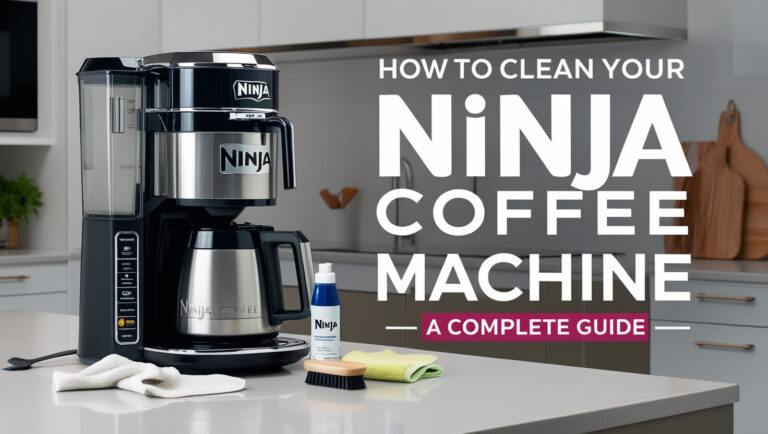How to Clean a Keurig Coffee Machine?

If you’re a coffee lover who relies on your Keurig for that perfect morning brew, you know how important it is to keep your machine in top shape. Cleaning your Keurig coffee machine regularly is crucial for maintaining the quality of your coffee and the longevity of your appliance. In this comprehensive guide, we’ll walk you through everything you need to know about how to clean a Keurig coffee machine effectively.
Why Cleaning Your Keurig is Essential
Before we dive into the cleaning process, let’s understand why it’s so important to keep your Keurig clean.
Impact on Coffee Taste
A clean Keurig means better-tasting coffee. Over time, coffee oils and mineral deposits can build up inside your machine, affecting the flavor of your brew. Regular cleaning ensures that every cup tastes as fresh and delicious as the first.
Preventing Bacterial Growth
The warm, moist environment inside a coffee maker is ideal for bacteria and mold growth. By cleaning your Keurig regularly, you’re not just maintaining its performance but also ensuring your coffee is safe to drink.
Extending Machine Lifespan
Proper maintenance can significantly extend the life of your Keurig. Regular cleaning prevents mineral buildup that can clog the machine’s components and lead to breakdowns.
Daily Keurig Maintenance Tips
Keeping your Keurig in top shape doesn’t have to be a time-consuming task. Here are some quick daily habits that can make a big difference:
Wiping Down the Exterior
Start each day by giving your Keurig’s exterior a quick wipe with a damp cloth. This simple step keeps your machine looking clean and prevents dust and grime from accumulating.
Emptying the Drip Tray
The drip tray catches coffee drips and overflow. Empty and rinse it daily to prevent mold growth and unpleasant odors.
Removing Used K-Cups
Always remove used K-Cups immediately after brewing. Leaving them in the machine can lead to mold growth and affect the taste of your next cup.
Weekly Keurig Cleaning Routine
A more thorough weekly clean will keep your Keurig running smoothly. Here’s what you should do:
Cleaning Removable Parts
Remove the water reservoir, lid, and drip tray. Wash these parts with warm, soapy water and rinse thoroughly. Let them air dry completely before reassembling.
Sanitizing the K-Cup Holder
The K-Cup holder can accumulate coffee grounds and oils. Remove it and wash it with warm, soapy water. Use a soft brush to remove any stubborn residue.
Wiping Internal Components
Use a damp, lint-free cloth to wipe down the internal parts of your Keurig, including the area around the K-Cup holder and the top of the machine where water drips down.
Monthly Deep Clean for Your Keurig
Once a month, give your Keurig a deep clean to tackle any buildup that regular maintenance might miss.
Cleaning the Water Reservoir
Remove the water reservoir and wash it thoroughly with warm, soapy water. Rinse well and let it air dry. This prevents any mineral buildup or algae growth.
Sanitizing the Drip Tray
While you clean the drip tray daily, a monthly deep clean is beneficial. Soak it in warm, soapy water for about 15 minutes, then scrub gently and rinse thoroughly.
Unclogging the Needles
The needles that puncture the K-Cups can get clogged with coffee grounds. Use a paperclip to gently clean out any debris in the needle openings. Be careful not to damage the needles.
How to Descale Your Keurig Coffee Machine
Descaling is a crucial part of Keurig maintenance. It removes mineral buildup inside your machine, which can affect performance and taste.
Signs Your Keurig Needs Descaling
Watch out for these signs that indicate it’s time to descale:
- Slower brewing times
- Not brewing full cups
- Unusual noises during brewing
- Changes in coffee taste
Descaling with Keurig Solution
Keurig offers its own descaling solution, which is easy to use:
- Empty the water reservoir and remove the water filter.
- Pour the entire bottle of Keurig Descaling Solution into the reservoir.
- Fill the empty bottle with water and add this to the reservoir.
- Place a large mug on the drip tray and run a brew cycle without a K-Cup.
- Repeat until the “Add Water” light comes on.
- Let the Keurig stand for 30 minutes with the power on.
- Rinse the reservoir thoroughly and fill with fresh water.
- Run at least 12 cleansing brews to rinse the machine.
Using Vinegar to Descale Your Keurig
If you prefer a natural alternative, white vinegar works well:
- Fill the reservoir with equal parts white vinegar and water.
- Run brew cycles until the reservoir is empty, discarding the contents of the mug after each brew.
- Let the machine stand for 4 hours with the power on.
- Rinse the reservoir and fill with fresh water.
- Run at least 12 cleansing brews with fresh water.
Replacing Keurig Water Filters
If your Keurig has a water filter, it’s important to replace it regularly for the best-tasting coffee.
Importance of Water Filters
Water filters remove impurities and chlorine from your water, which can affect the taste of your coffee and contribute to mineral buildup in your machine.
When to Replace Filters
Keurig recommends replacing the water filter every two months or after 60 tank refills, whichever comes first.
Step-by-Step Filter Replacement Guide
- Soak the new filter in fresh water for 5-10 minutes.
- Rinse the filter under running water for 60 seconds.
- Wash the mesh of the lower filter holder.
- Insert the filter into the upper filter holder and snap it closed.
- Place the water filter assembly into the water reservoir, ensuring it’s seated properly.
Troubleshooting Common Keurig Cleaning Issues
Even with regular cleaning, you might encounter some issues. Here’s how to address them:
Dealing with Mineral Buildup
If you notice scale buildup even after descaling, you may need to descale more frequently or use filtered water in your Keurig.
Fixing Clogged Needles
If your Keurig isn’t brewing properly, the needles might be clogged. Use the paperclip method mentioned earlier to clear any blockages.
Addressing Unusual Tastes or Odors
If your coffee tastes off, try running a few brew cycles with just water to flush out any residual cleaning solution or old coffee oils.
Natural Cleaning Solutions for Your Keurig
For those who prefer natural cleaning methods, here are some alternatives to commercial cleaners:
Vinegar and Water Method
We’ve covered this earlier, but it’s worth repeating. A solution of equal parts white vinegar and water is an effective, natural descaling agent.
Lemon Juice Cleaning Technique
Lemon juice can be used similarly to vinegar. Mix equal parts lemon juice and water for a fresh-smelling clean.
Baking Soda for Tough Stains
For stubborn stains on the exterior or drip tray, make a paste with baking soda and water. Apply, let sit for a few minutes, then wipe clean.
Maintaining Different Keurig Models
While the basic cleaning principles apply to all Keurigs, some models have specific care instructions.
Cleaning Keurig K-Elite
The K-Elite has a larger water reservoir, so ensure you’re thorough when cleaning it. Pay extra attention to the water level indicator during cleaning.
Sanitizing Keurig K-Mini
The K-Mini’s compact size means less surface area to clean, but don’t neglect the small spaces where grime can accumulate.
Caring for Keurig K-Duo
For the K-Duo, which brews both single cups and carafes, make sure to clean both the K-Cup and carafe brewing components regularly.
Preventing Future Buildup in Your Keurig
Prevention is always better than cure. Here are some tips to keep your Keurig clean for longer:
Using Filtered Water
Using filtered or bottled water can significantly reduce mineral buildup in your machine.
Regular Maintenance Schedule
Set a cleaning schedule and stick to it. Regular light cleaning prevents the need for more intensive cleaning later.
Proper Storage Tips
If you’re not using your Keurig for an extended period, empty and clean all components, and leave the lid off the water reservoir to allow air circulation.
Eco-Friendly Keurig Cleaning Practices
For the environmentally conscious, here are some green cleaning tips:
Reusable Cleaning Tools
Instead of disposable wipes or paper towels, use microfiber cloths that can be washed and reused.
Biodegradable Cleaning Solutions
Look for eco-friendly, biodegradable cleaning solutions, or stick to natural options like vinegar and lemon juice.
Recycling Used K-Cups
Many K-Cups are recyclable. Check the packaging and recycle appropriately to reduce waste.
Final Checkpoint: Enjoying Clean, Fresh Keurig Coffee
Cleaning your Keurig coffee machine doesn’t have to be a chore. With regular maintenance and the tips provided in this guide, you can ensure that your Keurig continues to brew delicious coffee for years to come. Remember, a clean Keurig is a happy Keurig, and a happy Keurig means better coffee for you!
By following these steps on how to clean a Keurig coffee machine, you’re not just maintaining an appliance – you’re ensuring that every cup of coffee you brew is as perfect as it can be. So, set aside some time for Keurig care, and enjoy the rich, flavorful results in every cup. Happy brewing!






